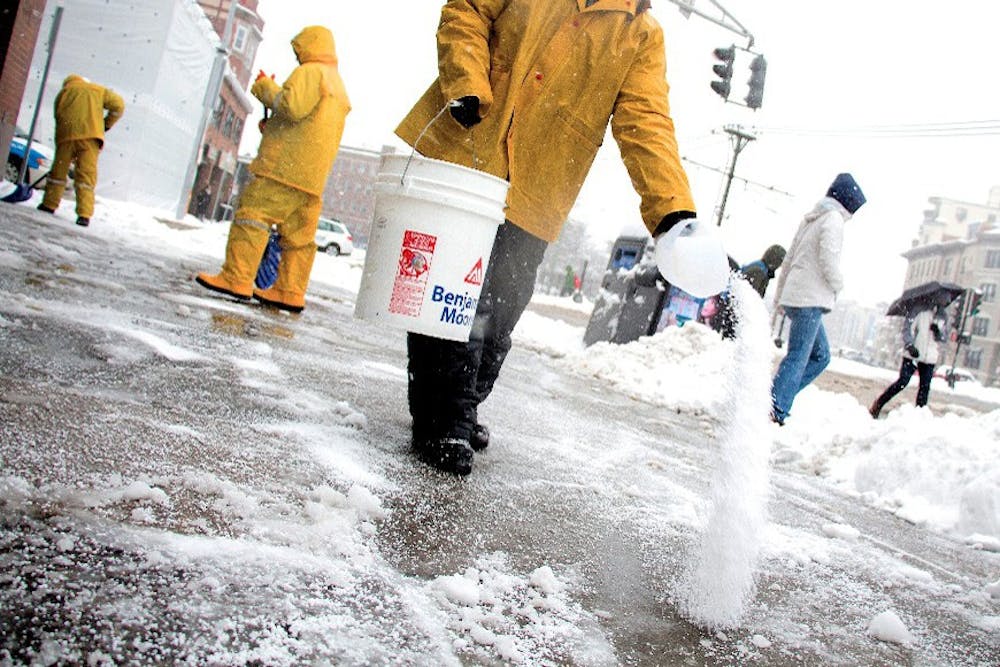
At Penn, with snow comes salt. Sometimes even before snow comes salt. It’s a winter hallmark — coating shoes, piled up in the corners between buildings and the ground and crunching underneath students’ boots as they walk to class.
When Penn uses salt, it washes into the Schuylkill River, which can contribute to toxic conditions. Regardless, Penn continues to use a lot of it. Alain Plante, who teaches earth and environmental science at Penn, posits that is using this much salt because it’s an easier, cheaper alternative to shoveling.
“Salt is too cheap,” he said. “The cost of salt fails to factor in the environmental externality.”
Externality, an economic term, is the implicit cost of something that isn’t necessarily reflected in how much it costs to purchase. So the externality of the salt Penn uses would not only include the amount of money that would eventually be needed to clean up streams, but also to wash off sidewalks in the short term where salt has left white residue and even ultimately to repair infrastructure that has been damaged over the years by salt’s caustic properties.
The obvious reason behind the salt is safety. It melts snow and ice and keeps people from slipping as they trek across campus. But the side of salt that many people don’t see is the impact on the environment. A study on the subject published by the United States Geological Survey in December 2014 said, “Average chloride concentrations often exceed toxic levels in many northern United States streams due to the use of salt to deice winter pavement, and the frequency of these occurrences nearly doubled in two decades.”
In many areas of the world — including Norway, Switzerland and Germany — the use of salt is severely restricted or even prohibited because of environmental concerns, according to earth and environmental science professor Reto Gieré. ”[I]n these cases, the cities use sand and gravel, which is better for the environment ... and does not create the slippery mess produced by salt,” he said in an email. “Therefore, it is even safer for both traffic and pedestrians. The sand and gravel can be collected after the winter and re-used, as demonstrated abroad.”
Plante hails from Canada, where he said sand and gravel is used primarily. But he also said Philadelphia provides conditions that may not be as conducive for the same method. “In places where it stays cold enough and the snow stays around, you can walk on [snow] and drive on it. Philadelphia hovers around freezing, which means there’s a lot more melting and refreezing, so ice is a bigger problem, which is part of the reason more salt is used.”
“Our treatment of Penn surfaces and landscapes is moving in a direction to follow our Climate Action Plan,” said Ken Ogawa, the executive director of operations and maintenance at facilities and maintenance, in an email. He also gave examples of prepping some areas with brine before snow and using something called “magic salt.”
Even with the movement toward these greener methods, a lot of salt can still be seen on sidewalks and on Locust Walk.
“There are areas and situations where things could be done better,” Plante said. “It ultimately comes down to one person responsible for that sidewalk, or that set of stairs. There should be a better training of staff, where they say ‘We are a green campus, we need to be judicial with this.’ We shouldn’t be taking the easy way out.”
The Daily Pennsylvanian is an independent, student-run newspaper. Please consider making a donation to support the coverage that shapes the University. Your generosity ensures a future of strong journalism at Penn.
DonatePlease note All comments are eligible for publication in The Daily Pennsylvanian.




